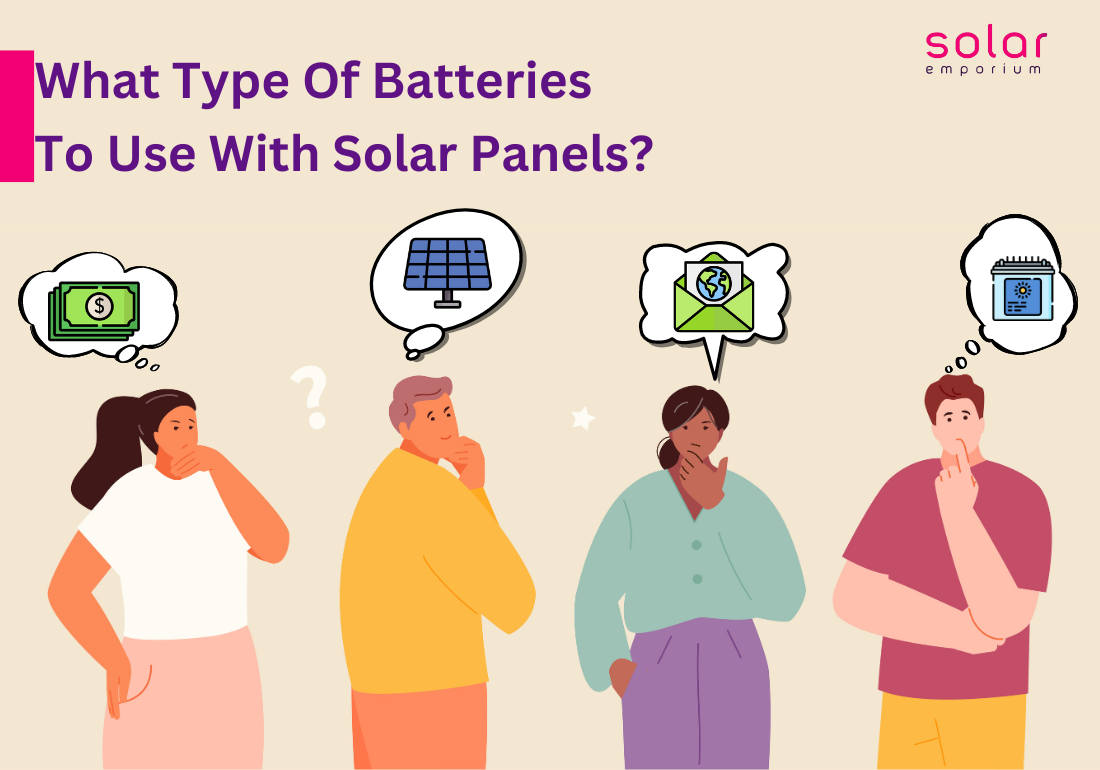Solar energy systems typically comprise solar batteries and panels, mounting tools, and an overall performance monitoring system. Solar energy systems
Most houses are connected to the grid. These systems are more commonly used for backup among homeowners. Many people, however, are looking for a replacement for their utility supply. One common reason people switch to solar is to avoid high energy costs.
So what type of batteries to use with solar panels to avoid high energy bills?
Various type of solar batteries are used as a backup for critical loads when the grid fails. You can choose from multiple types of solar batteries to use for your system. These solar batteries are designed to provide auxiliary power to the grid.
As we all know, four different types of solar batteries exist in the solar industry.
- Lead Acid Batteries
- Lithium-ion Batteries
- Nickel-cadmium (Ni-Cd) Batteries
- Flow Batteries
Lithium-ion and lead acid batteries are the most used of these four batteries. For a detailed review of all these batteries, check out our last blog about 4 different types of solar batteries.
Lead Acid Batteries
For many years, lead-acid batteries have been a reliable energy supply for off-grid areas. They are typically deep-cycle and low-cost. Lead-acid batteries are known for their high power and discharge current but low energy density. They can take up to 14 hours to charge fully.
Because of their highly toxic nature, these batteries should be thrown away properly. Otherwise, it can threaten the environment.
The flooded lead battery is dependable but must be watered and ventilated to function correctly. The VRLA comes in two varieties: gel and absorbed glass mat (AGM), which have valves for off-gassing regulation. These are appropriate for cold and warm temperatures. Although VRLA batteries provide enough installation flexibility, their temperature sensitivity may pose a challenge to people looking for a permanent alternative to their grid supply.

Lithium-ion Batteries
Lithium-ion batteries are becoming a more popular choice for solar systems worldwide. The development of this type of battery is heavily influenced by its application in the electric vehicle industry. Its prism shape allows ventilation which is beneficial in solar systems.
Lithium-ion batteries have a distinct voltage range and charging response. A voltage regulator charge controller is used to charge them. Despite low self-discharge, lithium-ion batteries do not benefit from long-term charging.
This type of solar battery requires little to no maintenance and has a high energy capacity and a long lifespan. Lithium batteries are evidently more expensive than lead-acid batteries. They may also need a protection circuit to regulate the current and voltage.
Lithium-ion batteries can provide more cycles than lead-acid batteries. It makes them ideal for providing additional services to the grid. Lithium-ion batteries’ high charge and discharge efficiencies make them an excellent choice for solar systems.
These batteries also lose less capacity when unused. That is very beneficial in solar installations where energy is only used occasionally.
In Comparison, Which Battery Is Better?
Capacity
The capacity of a solar battery simply describes its ability to store electrical power. Because of their heavier weight, lithium batteries have a higher degree than all other types of lead-acid batteries.
To power a 5.1kW, you’ll need about 8 lead-acid batteries, whereas two lithium-ion solar batteries will suffice.
Because lithium batteries have a higher energy density. They can be installed in difficult places because they can also fit more capacity into less space. Both nickel-cadmium and sodium nickel chloride have a broad capacity range.
DoD (Depth Of Discharge)
The DoD of a solar battery is the usable portion of its capacity, and a DoD of at least 40% is recommended for optimal battery usage. Lead batteries have a DoD of 50%, whereas nickel-cadmium batteries have a DoD of 15%.
Exceeding this limit before recharging reduces battery life. In contrast, lithium-ion and sodium nickel chloride solar batteries have an 80% DoD, implying a higher usable capacity.
Warranty Of Solar Batteries
When deciding which solar battery to use in your system, consider its battery life as the best indicator of its ability to retain capacity. One charge cycle is the chargeback up from a discharge and is the primary determinant of battery lifespan.
In addition, the number of cycles your solar battery will go through will be determined by the frequency with which it is used. This characteristic varies even for the same type of solar battery and is influenced by the battery’s depth of discharge.
A warranty is always a good indicator of dependability in any brand or product, including solar batteries.
Effectiveness
The round-up efficiency is the difference between the available energy and the amount of energy used to charge a solar battery.
The higher a battery’s round-trip efficiency with the DoD, the better. Regarding 95% efficiency, lithium-ion solar batteries win because they have the most conversion rate from solar power.
This means that depending on the configuration of your system, you may need to install fewer solar panels and batteries.
Charge Rate
Another factor to consider when purchasing a solar battery is the charge rate. It indicates how quickly a battery will be recharged when connected to a charger. It is expressed in fractions like C/4 function capacity.
With a charge rate of C/5, lead-acid solar batteries can take up to twice as long to charge as lithium-ion solar batteries, especially during peak hours.
Lithium-ion batteries and flooded lead-acid are ideal for full-time, off-grid power at various levels of use. If you need a battery for a vacation home or somewhere you won’t spend much time during the year, a sealed lead-acid battery is your best bet.
It has a low self-discharge rate and requires no maintenance.
You must consider power outages when purchasing a battery solely for backup purposes. It will help determine how frequently you’ll need your grid supply throughout the year.
A low-maintenance battery, such as a sealed lead-acid solar battery, will be more beneficial if only used a few times.

However, after examining other comparisons, lithium-ion batteries are the correct choice. These batteries have better capacity, DoD, warranty, and charge rate.
Considering these parameters, you can accurately plan and install your solar system. You can choose which type of solar battery is best for you based on your intended system use.
What Is A Solar Charge Controller?
The solar charge controller is a device that connects your solar panels and batteries. The controller ensures that your batteries are not “overcharged.” Overcharging your batteries causes them to overheat and catch fire.
A controller also determines how to properly charge your batteries by varying the flow of amps and voltage rate based on the battery manufacturer’s recommended specifications.
The market is flooded with low-cost solar charge controllers. There are better places to cut corners. Spend a little more money on a high-quality solar charge controller.
All batteries are replaced at some point. Therefore, you need to decide wisely on the storage system. You’ll need to spend more time researching if you buy expensive batteries. It will help manage them more to get the most out of them.







